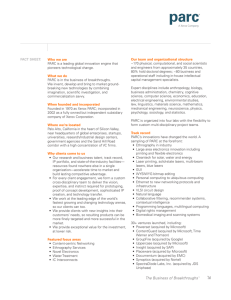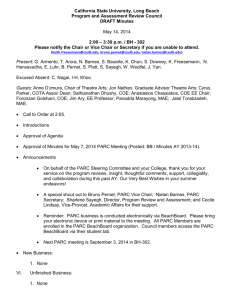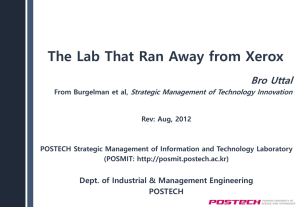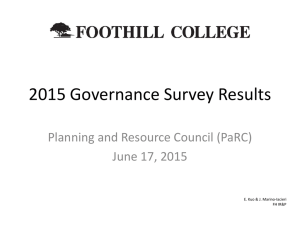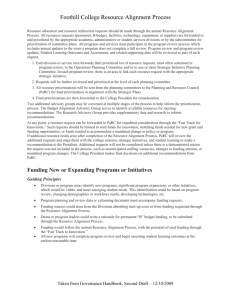2010 ANNUAL REPORT
advertisement
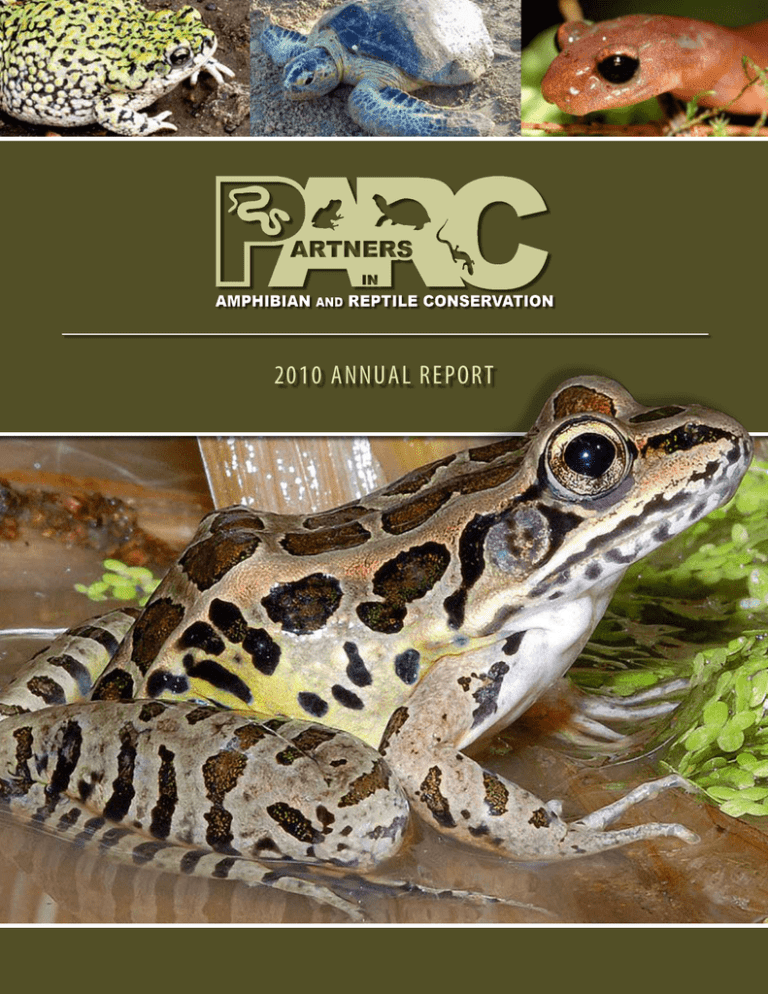
2010 ANNUAL REPORT ACKNOWLEDGMENTS CREDITS: Front Cover photos: Large background, pickerel frog (John White), Top Row, toad (Larry Jones), sea turtle (John White), ensatina salamander ( Paul Block) Back Cover: copperhead snake (John White) Page 2 photos: Top Row, squirrel treefrog (JD Wilson), Sonoran collared lady lizard (Larry jones), red-backed salamander (Victor Young/NHFG), Inset, red salamander (JD Wilson) Page 3 photos: Top Row, king snake, sea turtle, green tree frog (John White) Page 2-3 background: longleaf pines (Jeff G. Hall) Editors: Terry Z. Riley, Priya Nanjappa, Deanna H. Olson, and Alvin R. Breisch Suggested Citation: Riley, T.Z., P. Nanjappa, D.H. Olson, and A.R. Breisch. 2011. Annual Report: 2010. Partners in Amphibian and Reptile Conservation (PARC), Annual Report No. 1, Hagerstown, MD. 16pp. Available Online at: www.parcplace.org 2010 PARC ANNUAL REPORT INTRODUCTION PARC MISSION To conserve amphibians, reptiles and their habitats as integral parts of our ecosystem and culture through proactive and coordinated public/private partnerships. A mphibians and reptiles are affected by a broad range of human activities, both as incidental effects of habitat alteration and overexploitation, and due to the perception that these animals are either dangerous or of little environmental or economic value. However, their ecological values are well known, and they are important parts of our natural and cultural heritage. Worldwide, approximately half of turtles and one-third of amphibians are listed as ‘threatened’ with extinction. Preservation of these animals has never been more important. Partners in Amphibian and Reptile Conservation (PARC) was established in 1999 to address the widespread declines, extinctions, and range reductions of amphibians and reptiles, with a focus on taxa in the United States. PARC is an inclusive partnership dedicated to the conservation of herpetofauna–reptiles and amphibians–and their habitats. One of the most ambitious conservation partnerships in the country, PARC brings together representatives of science and education, species conservation and land management, industry and commerce, state and federal government, conservation societies, pet and field hobbyists, and the general public from across the US plus Canada and Mexico. PARC now stands alone internationally as being the only partnership to address the conservation of all amphibians and reptiles. The diversity and inclusivity of both its membership and its species coverage makes PARC the most comprehensive conservation effort ever undertaken for amphibians and reptiles. PARC is not a funding or government agency. It does not create or dictate policy. Rather, it provides recommendations and guidelines based on sound science, consensus among scientists, and common sense. PARC focuses on increasing communication and cooperation with many diverse groups who have a common interest in amphibians, reptiles, and their habitats. Through publications such as their Habitat Management Guideline (HMG) series, PARC helps individuals to be informed about how they or their partner agencies, companies, or organizations can contribute to the conservation and management of habitats. 2010 PARC ANNUAL REPORT www.parcplace.org 2010 PARC Projects and Products PARC continued to build on its development of a variety of solution-oriented resources to guide conservation actions in 2010. Habitat Management Guidelines (HMG): During 2010, PARC continued its work to complete its flagship, five-volume HMG series that will cover the continental U.S. and parts of Canada. Specifically, PARC made progress in the development of the Midwest and Southwest regional books. Each volume in the series covers a regional geographic area that is largely based on ecoregions. Both the Midwest and Southwest volumes are expected to be completed in 2011, thus completing the entire series. Coverage and overlap of the regionally-based PARC Habitat Management Guidelines. Inventory and Monitoring Techniques Book: In September 2010, a final draft of PARC’s newest technical publication, Inventory and Monitoring: Recommended Techniques for Reptiles and Amphibians with Application to the United States and Canada was sent to the publisher. The objective of this handbook is to provide land managers and landowners with information about reptiles and amphibians and the qualitative and quantitative techniques that can be used to obtain information on diversity, distribution, and abundance of these animals. It will be user-friendly, address both reptiles and amphibians, and provide specific recommendations on techniques that may be used for each species. A final courtesy review among our partners, as well as final printing, is planned in 2011. In 2010, PARC also conducted preliminary development of inventory and monitoring training modules to occur in conjunction with regional meetings in 2011 and 2012, to take the book to the field. 2010 PARC ANNUAL REPORT www.parcplace.org Priority Areas for Amphibian and Reptile Conservation (PARCA): © nhfg / victor young © john white © larry Jones Roads Task Team: The Roads National Task Team was created to partner with transportation entities to help develop and consolidate solutions and conservation strategies to address passage, connectivity, collision, and other transportation-related issues for amphibians and reptiles. In July 2010, a workshop was held at the Joint Meetings of Ichthyologists and Herpetologists in Providence, RI where primarily nonherpetologist, transportation ecology experts spoke about lessons and needs for passage design and conflict avoidance. A planning manual is in development to provide guidance to transportation professionals regarding the state-of-ourknowledge in construction of culverts, tunnels, stream overpasses or related structures to benefit herpetofauna, as well as fish and other taxa. PARC expects the manual to be published in 2012. © john white © john white Identifying priority habitat areas for amphibians and reptiles is increasingly important, particularly in the face of climate change, growing human populations, and urban, commercial, and energy-related development. To this end, the PARC Important Herp Areas National Task Team finalized criteria and an implementation plan for designating Priority Amphibian and Reptile Conservation Areas (PARCAs) in November. Prepared by the PARC Important Herp Areas National Task Team, the criteria and plan began a final technical review in December 2010, which was anticipated to extend through January 2011. A final technical review of the PARCA criteria and implementation plan was initiated in December. 2010 PARC ANNUAL REPORT www.parcplace.org Joint National Steering Committee PARC’s Joint National Steering Committee (JNSC) is the decision-making body of PARC, ensuring implementation of the PARC mission. During monthly conference calls, email and annual in-person meetings, the JNSC identifies program-wide priorities and actions. The JNSC works to provide effective communication and coordination among the various partners, task teams and regional working groups of PARC. 2010 Co-Chairs Dede Olson (US Forest Service, Oregon), Mike Lannoo (Outgoing, Indiana University)and Al Breisch (Incoming, retired, former New York State wildlife biologist) In 2010, the JNSC was led by the national PARC CoChairs (Dede Olson, Mike Lannoo, Al Breisch), and the State and Federal Agency Coordinators (Priya Nanjappa, Terry Riley). Topics discussed by the JNSC in 2010 included: © nhfg / victor young 1) Regional Working Group annual meetings and activities; 2) Establishment of PARC liaisons to the U.S. Department of the Interior’s Landscape Conservation Cooperatives; 3) New Department of Defense (DoD) PARC initiative and development and initial drafting of a DoD PARC Strategic Plan; 6) State Regulations synthesis and climate change vulnerability analysis coordinated by the Association of Fish and Wildlife Agencies; 4) Plans for increased engagement in the future on Farm Bill programs and related state technical committees; 7) Progress and projected completion of the Midwest and Southwest Habitat Management Guidelines; 5) Roads National Task Team Symposium conducted at the Joint Meeting of Ichthyologists and Herpetologists (JMIH) and related roads planning manual; 8) Completion of the Inventory and Monitoring handbook; 9) Completion and final review of the Priority Amphibian and Reptile Conservation Areas (PARCA) document (formerly “Important Herp Areas”); Internal Leadership 10) PARC’s role in the initiation of a US federal working group on lizards and climate change; Joint National Steering Committee (JNSC) 11) Development of criteria for the Alison Haskell Award; External Advisory Committees Federal, State, Industry, NGO 12) Filling the vacated positions of the PARC Federal Agency Coordinator and National Co-Chair; National Coordination National State and Federal Agencies Coordinators 13) Redesign of the PARC web page; and 14) The 2011 Year of the Turtle campaign planning, web page development, logo contest, photo contest initiation, newsletter and calendar initiation. The JNSC also worked closely with Friends of PARC to communicate funding requests for support of various symposia and workshops, and to support the coordination of the 2011 Year of the Turtle activities and products. Regional Steering Committees Regional Working Groups 2010 PARC ANNUAL REPORT www.parcplace.org PARC Regional Working Group Activities 2010 Co-Chairs © jennifer hedin Kent Bekker (Toledo Zoo, Ohio), Karen Kinkead (Outgoing, Iowa Department of Natural Resources) and Rich King (Incoming, University of Northern Illinois) MW PARC Task Teams: • Blanding’s Turtle Core Areas Task Team is developing a white paper using past telemetry studies to establish needed core area sizes. • Blanding’s Turtle Habitat Management & Monitoring Task Team is developing a white paper with management recommendations and survey & monitoring techniques specifically for Blanding’s turtles. PARC’s Regional Working Groups are the foundation of PARC, and are where the on-the-ground issues are translated into action and products • Blanding’s Turtle Distribution Mapping Task Team is developing current distribution maps with township-level resolution for Blanding’s turtles. Midwest Regional Working Group (www.mwparc.org) • Best Blanding’s Turtle Populations Task Team is identifying an area with the “best’ population of Blanding’s turtles. T he Annual Midwest Regional Working Group (MW PARC) meeting was held August 13-15, 2010 at the Lorado Taft Field Campus in Oregon, IL. The theme of the meeting was Blanding’s Turtle Biology, Conservation, and Management, and Dr. Justin Congdon (Professor Emeritus, University of Georgia) presented the keynote address. Eighty-three people attended. Two field trips were offered with almost 30 people participating in one and more than 40 participating in the other. In addition to the keynote address, there were 15 invited speakers and 11 posters presented. The presentations included talks on management, phylogeography, reproductive ecology, monitoring, and recovery efforts. Dr. Rich King was elected as the new co-chair for MW PARC and joins Kent Bekker. © jason ross The Richardson Wildlife Foundation is an Illinois notfor-profit corporation established in 1989 with the goals of Habitat Restoration and Development; Conservation Education; and Research. Richardson Wildlife Foundation encompasses 1800 acres of native and restored prairie, wetland, and forest. Blanding’s turtles and ornate box turtles are both found on the site and four Blanding’s turtles were captured in traps set prior to MW PARC field trips – the first records for 2010! 2010 PARC ANNUAL REPORT www.parcplace.org Northeast Regional Working Group (www.pwrc.usgs.gov/neparc/) N ortheast Partners in Amphibian and Reptile Conservation (NE PARC) had a productive year. The annual meeting was held August 10–11 at Schoodic Education and Research Reserve (SERC), Acadia National Park, Maine. Approximately 90 people attended the meeting. The keynote speaker was Dr. David Green, Redpath Museum, McGill University, who spoke on “How Amphibians Conquered the North.” NE PARC also invited Andrew Milliken, US Fish and Wildlife Service, to speak on the recent developments with the North Atlantic Landscape Conservation Cooperatives. This was the first year NE PARC solicited abstract submissions to help determine speakers for the meeting. The process worked well and we will be pursing that in the future. Several of the NE PARC’s active working groups met at the meeting to work on current initiatives and prioritize next steps. 2010 Co-Chairs Mary Beth Kolozsvary (New York State Museum), Dave Golden (Outgoing, NJ Division of Fish and Wildlife) and Valorie Titus (Incoming, Bronx Zoo and Wildlife Conservation Society) © nhfg / victor young NE PARC was represented at several meetings including the PARC steering committee meeting held at the North American Wildlife and Natural Resources Conference, Milwaukee, Wisconsin (attended by Dave Golden, co-chair) and the Rhode Island Natural History Survey meeting “Emerging Threats of Amphibian Conservation in New England with Attention to Chytrid and Ranavirus” (attended by Mary Beth Kolozsvary, co-chair). Valorie Titus was elected to a 2-year term as co-chair (replacing Dave Golden). Phillip deMaynadier (Maine Department of Inland Fisheries and Wildlife), steering committee member, participated on national PARC’s Priority Amphibian and Reptile Conservation Areas Task Team. The team is nearing completion of the “Model Criteria and Implementation Guidance for a Priority Amphibian and Reptile Conservation Area (PARCA) System in the US.” The working groups have been especially productive this year. Several products are now available as down- © jeff g. hall loadable PDFs on the NE PARC website, including a summary of vernal pool regulations in the Northeast, box turtle poster and report observations, wood turtle brochure, and the “Northeast Amphibian and Reptile Species of Regional Responsibility and Conservation Concern.” Although several of these products had been near completion for quite some time, NE PARC’s editorial board recently worked out a process for reviewing products prior to releasing them to the public. We look forward to this process enabling us to be much more productive in the future. 2010 PARC ANNUAL REPORT www.parcplace.org Northwest Regional Working Group (www.nwparc.org) N orthwest Partners in Amphibian and Reptile Conservation (NW PARC), the ID Chapter of PARC, and the ID chapter of The Wildlife Society held a joint Annual Meeting in Boise, ID in March 2010 (lead – David Pilliod). NW PARC hosted a well-attended symposium titled “Wildlife Conservation and Energy Development in the Northwest.” Talks covered topics such as energy development and Sage grouse, oil and gas development in Wyoming, wind development in Idaho, and independent power projects in British Columbia. Two new task teams were created during group discussions at the annual meeting: Regulations, and Fish Stocking Literature Review. An additional informal meeting was held in Medford, Oregon in February 2010 in conjunction with the annual meeting of the Society for Northwestern Vertebrate Biology. 2010 Co-Chairs Elke Wind (E. Wind Consultants, British Columbia, Canada) and David Pilliod (USGS, Idaho) © brome mccreary NW PARC collaborated with the U.S. Forest Service, the U.S. Bureau of Land Management, and the Trinity River Restoration Program (TRRP) to present a Wetland Construction Workshop in Weaverville, CA in October 2010 (leads – Elke Wind, consultant and Ernie Garcia, TRRP and Friends of PARC). Over the two-day workshop, the 31 attendees from CA, NV, ID, UT, and WA learned how to use low cost, effective techniques for restoring wetlands, including how to assess site conditions for determining the location, size, and type of wetland to be constructed, choosing reliable construction techniques, working with heavy equipment operators, and establishing native plants. reptile-friendly farming and ranching pamphlet in 2010 (lead - Kris Kendell, Alberta Conservation Association). The objective is to use the listed northern leopard frog in Alberta as a focal species to highlight issues and the use of environmentally friendly practices. The team aims to work with PARC members in Montana and Idaho to expand the material and training into other states and provinces in the future. © brome mccreary NW PARC sponsored an international intern from Alaska to work with PARC on the upcoming 2011 Year of the Turtle (YoT). Joshua Ream, a graduate student from the University of Alaska, lived in Vancouver, BC for four months researching and developing turtle-related educational materials, giving presentations to school groups, compiling information for the PARC YoT website, and initiating discussions with local First Nations on the role turtles play in their cultures. Joshua Ream is chair of the newly founded Alaska Chapter of NW PARC. NW PARC spent time in 2010 collaborating with BC Frogwatch, Ministry of Environment, Ministry of Transportation and Infrastructure, the Association of Wetland Stewards for Clayoquot and Barkley Sounds, and the Biology Department of Vancouver Island University for a co-hosted two-day Herpetofauna and Roads Workshop to be held in Nanaimo, BC in February 2011 (lead – Elke Wind, consultant). The main objective of this workshop is to bring scientists, environmental managers, and engineers together to discuss the impacts of roads on herpetofauna and mitigative measures that can be taken to reduce those impacts. Members of NW PARC’s Training Task Team initiated work on an amphibian-and 2010 PARC ANNUAL REPORT www.parcplace.org Southeast Regional Working Group (www.separc.org) 2 010 was a productive year for Southeast Partners in Amphibian and Reptile Conservation (SE PARC) and they are looking to the future with the goal of continuing that momentum into 2011. In 2010, SE PARC formed a steering committee that is composed of approximately 15 members representing a range of entities including federal and state agencies, universities, zoos, private industry, and non-profit conservation organizations. Shortly after formation, at the beginning of 2010, the committee worked on developing their Structure Document that outlines how SE PARC functions including describing officer positions and associated duties and terms. They also had a very productive meeting in February 2010. The meeting was held in Ocala, Florida and had almost 200 participants. SE PARC received an inspiring keynote speech from Dr. Bruce Means, Coastal Plains Institute and Land Conservancy, on the Conservation of Southeastern Coastal Plains Ecosystems. Many other students and professionals gave oral and poster presentations; all of their task teams met and discussed progress; and they conducted multiple workshops including Climate Change Modeling, Occupancy and Detection Modeling, and Herp Partnerships, to name a few. At the 2010 meeting 2010 Co-Chairs © j.d. wilson Gabrielle Graeter (North Carolina Wildlife Resources Commission), Betty Crump (USDA Forest Service), and Chris Jenkins (Incoming, The Orianne Society) they awarded the first annual SE PARC Conservation Hero Award to John Byrd of the Clinch River Environmental Studies Organization in Eastern Tennessee for his work on educating high-school and middle-school students by doing hands-on field research with them. © j.d. wilson In 2010, the SE PARC steering committee began working on a number of long-term projects. Specifically, the committee is workingtowards having their website set up through a Wiki site which will allow each steering committee member to individually update the website, as needed. They also have decided to develop a Species Priority List for the SE region including initial discussions on the approach we will implement to determine species level priorities. SE PARC began working with the Landscape Conservation Cooperatives (LCC) by setting up SE region points of contact and their chair has had initial meetings with LCC staff to determine the best way for SE PARC to become an important partner. Finally, they are in the process of planning their 2011 meeting that will be held at Lake Tiak-O’Khata in Louisville, MS (http://www.ltok.com/) from Feb. 17-20, 2011. 2010 PARC ANNUAL REPORT 10 SE PARC Task Team Updates, Invasive Species: A Pet Options brochure with resources about what to do with an unwanted pet was completed; 4000 copies and the brochure is on SEPARC website. A Pet Buyer’s Guide brochure was completed and has been posted on their website. Development of management guidelines for property landowners that are dealing with invasive herp species was begun in 2010 and should be completed in 2011. www.parcplace.org Southwest Regional Working Group (www.swparc.org) S outhwest Partners in Amphibian and Reptile Conservation (SW PARC) had another busy year in 2010. They hosted their fourth annual meeting in Fort Collins, Colorado in August with the theme Amphibians and Reptiles in the SW: Management in a Rapidly Changing Environment. There were 54 participants from all but one state in the region and attendees from two states outside the region. In addition, they hosted their second annual herpetological inventory and monitoring training immediately preceding their annual meeting, with 24 participants. Brian Aucone (Denver Zoo), Rob Lovich (Outgoing, U.S. Navy), and Larry Jones (Incoming, US Forest Service, Arizona) © j.d. wilson At the annual meeting, SW PARC members identified four new/continuing tasks including development of a priority species list in the southwest region, outreach to enthusiasts, Year of the Turtle, outreach to Mexico and educational outreach programs. Working groups were formed for each of these tasks and there was progress on most of these tasks through the remainder of the year. SW PARC members were particularly excited about the priority species list and a scoring matrix was developed and completed in 2010 for all herps in the region. It will be going through an editorial/evaluation phase in early 2011 and will be included in the HMG. 2010 Co-Chairs SW PARC was also able to secure the domain www. swparc.org, making it easier for people to find us on the web. They also did a minor overhaul of their website, making it user friendly and containing a greater breadth of information. © polly conrad The best news for SW PARC in 2010 is the great progress on the SW HMG, which is moving into formatting and publication in 2011. In addition, SW PARC has been able to secure approximately 25% of the funding towards the HMG publication costs, primarily through a generous donation from the Oklahoma City Zoo. 11 Toward that end of 2010, SW PARC participants were excited to take on the challenge of providing bio-monitoring training for Flat Tailed Horned Lizards (Phrynosoma mcalii). Details are currently being developed with the hope of offering our first training occurring in the first half of 2011. And as always, they are working on details of their next annual meeting/training to be held August 2011 in Tucson, Arizona. Look for details at www.swparc.org. 2010 PARC ANNUAL REPORT www.parcplace.org PARC Federal Agency Partner Activities Federal Agencies Steering Committee 2010 Co-Chairs I n March and September 2010, the PARC Federal Agencies Steering Committee (FASC) met to discuss issues of concern regarding amphibians and reptiles on federal lands or under federal protection. The FASC also discussed: Rick Bennett (FWS), Amy Krause (Outgoing, BLM), and Dave Schmid (Incoming, USDA Forest Service) 1) Transfer of the administration of the Federal Agencies’ Coordinator position from the US Fish & Wildlife Service (Region 5) to the National Park Service (Fort Collins, CO) In Fall 2010, Terry Riley, Ph.D., was hired via the National Park Service (NPS) as the new PARC Federal Agencies’ Coordinator. Terry brings broad ecological and conservation experience to his new position, including over a decade with the Wildlife Management Institute, many years of private lands conservation activities, and experience with wildlife and energy development considerations. He will join the staff of the NPS Biological Resource Management Division in Fort Collins, Colorado. He has begun working with the regional co-chairs and the PARC Joint National Steering committee, distributing Habitat Management Guidelines and looking for new sources of support for PARC Terry Riley, Ph.D. products and activities. He is the federal counterpart to the AFWA Amphibian and Reptile Coordinator, the states’ coordinator to PARC, with the two positions working very closely together to coordinate federal and state amphibian and reptile conservation issues and activities. 2) Filling the vacated Federal Agencies’ Coordinator position; 3) Identifying federal agency priorities and potential performance measures around herpetofauna conservation activities; 4) Establishment of PARC liaisons to the U.S. Department of the Interior’s Landscape Conservation Cooperatives; 5) New Department of Defense (DoD) PARC initiative and development and initial drafting of a DoD PARC Strategic Plan; 6) Plans for increased engagement in the future on Farm Bill programs; and 7) Funding arrangements and MOU renewal for the Federal Agencies’ Coordinator position. In the Fall of 2009, the former Federal Agencies’ Coordinator, Ernie Garcia, retired after more than 30 years of federal service with primarily the USDA Forest Service and ultimately the US Fish & Wildlife Service in his role with PARC starting in 2004. Ernie continues to work with PARC in various capacities, including as the interim Executive Director of Friends of PARC, the non-profit entity that supports PARC activities. 2010 PARC ANNUAL REPORT Department of Defense – PARC Initiative On February 12, 2010, a memo from Assistant Deputy Undersecretary of Defense, John Conger, was sent to the Deputy Assistant Secretaries of the armed services to inform them of a new Department of Defense (DoD) PARC initiative and Strategic Plan. In April and June 2010, scoping workshops were held among DoD members and PARC leadership, supported by DoD Legacy funds approved in 2009, to initiate development of the DoD PARC Strategic Plan. In December 2010, a draft of the Plan was submitted to the DoD Legacy Resource Management Program and is going through formal review by military services. The pre-final Plan will be presented during the National Military Fish & Wildlife Association (NMFWA) meeting in March 2011, with a final version to be completed as early as May 2011. This important plan will ultimately result in implementation of the first agency-wide strategic plan for herpetofauna in the federal government. 12 www.parcplace.org Another 2009 DoD Legacy Resource Management Program-funded project, “Do Frogs Still Get Their Kicks on Route 66” involved sampling for the amphibian chytrid fungus, Batrachochytrium dendrobatidis, or “Bd” at 15 military installations that formed an east-west transcontinental transect. In 2010, these samples were analyzed, a final draft report was completed, and the resulting manuscript was drafted and submitted for scientific publication in January 2011. Funding was awarded in 2010 for a second Bd surveying effort planned for an additional 15 DoD sites along three north-south transects in 2011. Monument. The Idaho BLM State Office has partnered with Colorado State University and the Idaho Department of Fish and Game in evaluating the population genetics of Columbia spotted frogs (Rana luteiventris) in southwestern Idaho. Objectives of the study include estimating genetic connectivity among populations, identifying the number and spatial distribution of distinct populations, estimating effective population sizes and testing for population declines using genetic bottleneck tests. While amphibians and reptiles regularly benefit from the planning, design, and implementation of Natural Resources Conservation Service (NRCS) conservation practices that are supported by USDA Farm Bill programs, the following is an example where one of those taxa is the specific focus of the Wetlands Reserve Program (WRP) and the Environmental Quality Incentive Program (EQIP). WRP permanent easements were secured with eight landowners in five Pennsylvania counties totaling almost 120 acres. Essential bog turtle areas can be small (< 5 ac), and land ownerships in SE PA tend to be small, further fragmenting the habitat. One aspect of the initiative is to include protective buffers adjacent to these habitats. Longterm management of bog turtle sites includes prescribed grazing to maintain herbaceous vegetation and an open canopy. PARC members also contributed to the April 2010 issue of the DoD Publication, Natural Selections. This issue was centered on amphibians and reptiles and conservation efforts on military lands. © blaine rothhauser PARC members continued to work with the NMFWA Herpetological Working Group (HWG) in providing information to military installation natural resources staff through the annual HWG NMFWA session and via the HWG Newsletter. The annual NMFWA HWG meeting provides PARC representatives the opportunity to speak to the Working Group and discuss ways PARC can provide technical assistance to installations to ensure proper consideration of herpetofauna in management practices. It also provides the opportunity to discuss potential cooperative agreements between PARC and DoD installations. This collaborative effort between PARC and DoD continues to build awareness at the installation level on better ways to manage military lands in support of both the military mission and ecosystem. Bureau of Land Management The Bureau of Land Management (BLM) has been quite active in the herpetological world in 2010. In Colorado, the boreal toad and leopard frog were inventoried and several new areas were evaluated for habitat potential. A road improvement project was completed partially to protect their habitat. Several other amphibians – Great Plains toad, tiger salamanders, northern leopard frogs, western chorus frogs, and Plains spadefoot toad – were monitored in 2010. Results of 9 years of data are now being used to target certain wetland areas for various species’ life-cycle needs species and gear irrigation techniques to enhance the habitat. The spiny softshell turtle is a Montana Species of Concern and BLM Designated Sensitive Species. BLM is participating as a cooperator in a study which will identify essential habitat components within the Upper Missouri River, along 150 miles of Wild & Scenic River managed as part of the Upper Missouri River Breaks National U.S. Geological Survey (USGS) Amphibian Research and Monitoring Initiative (ARMI) activities in partnership with National Park Service T he Southern Rocky Mountain ARMI group has been contributing to the reintroduction of boreal toads in Rocky Mountain National Park. They have been working closely with Park personnel on initial site selections, site assessments, and final decisions about what sites to target for reintroduction. They have used non-invasive swabs to test for the amphibian chytrid fungus (Bd) on target and non-target species and in the environment. Not only has ARMI been collaborating with the Park to release tadpoles in multiple years, they also have released a small number of radiotagged adults to function as disease sentinels and to assess the movements and habitat use of introduced individuals. 13 2010 PARC ANNUAL REPORT The National Capital Region Inventory and Monitoring Network of the National Park Service has identified species diversity of amphibians as a “vital sign” for natural resource management. The region is under threat from both urbanization and climate change, and USGS scientists with the Northeastern Amphibian Research and Monitoring Initiative (NE ARMI) have found that both factors may be regulating amphibian occupancy. Surveys have identified 12 species of amphibians breeding in wetlands at the Chesapeake and Ohio Canal NHP, which are likely to respond differently to these large-scale changes. In response, the Park resource managers, the I&M regional office, and biologists with ARMI are using an adaptive management framework to maintain species diversity within the park. NE ARMI biologists continue to monitor wetland habitats to detect response to both the largescale threats, and to evaluate management actions. national park service www.parcplace.org Boreal toad reintroduction in Rocky Mountain National Park. PARC State Fish & Wildlife Agency Partner Activities Association of Fish and Wildlife Agencies and Amphibian & Reptile Subcommittee will be posted online in early 2011. Subcommittee member Polly Conrad (NV), a former SW PARC Co-chair, was instrumental in assisting with the compilation of these regulations for the report. Additionally, a work group, formed during the 2009 summit, continued to develop recommendations for model regulatory approaches in the context of the North American Model for Wildlife Management. Amphibian and Reptile Subcommittee The Amphibian and Reptile Subcommittee, reporting to the Wildlife Resource Policy Committee of the Association of Fish and Wildlife Agencies (AFWA), was initiated in 2008, and serves as the States’ advisory committee to PARC. The Subcommittee is staffed by the AFWA Amphibian and Reptile Coordinator, Priya Nanjappa, who also serves as the national coordinator on behalf of the states to PARC, the counterpart to the PARC Federal Agencies’ Coordinator. Initially led by Dave Erickson (MO), who retired in Fall 2009, and with interim leadership from Gordon Myers (NC), the Subcommittee welcomed Ed Carter (TN) in 2010 as the new chair. Eric Gardner (AZ) continues to serve as vicechair. The Subcommittee met in both March and September and discussed issues ranging from hot button issues such as non-native constrictor snake and native herpetofauna regulations, to climate change impacts and monitoring. In September 2010, the Subcommittee partnered with the USFWS International Wildlife Trade Program in a workshop, Conservation and Trade Management of Freshwater and Terrestrial Turtles in the United States. Attendance at the workshop included over 90 biologists and law enforcement professionals representing 34 states and the District of Columbia, scientific experts, and federal agencies. The results of this workshop will be incorporated into the Subcommittee’s regulatory recommendations, to be reviewed by other AFWA committees (Sustainable Use of Wildlife, International Relations, Teaming With Wildlife, among others) and to be finalized in early 2011 as guidance for states as they consider new or enhanced regulatory or management approaches. As a result of the Subcommittee’s November 2009 national regulatory summit (in partnership with the Law Enforcement Committee), Subcommittee members and state partners spent 2010 updating and expanding their draft national report, State of the Union: Legal Authority over the Use of Native Amphibians in the United States. This report was finalized in December 2010 with input and review from all 49 continental states and the District of Columbia, and In December 2010, Dr. Kyle Barrett (University of Georgia) presented his pilot climate vulnerability analysis of amphibians and reptiles, funded via the Subcommittee’s 2009 Competitive State Wildlife Grant, as part of the USFWS-NWF webinar series on Safeguarding Wildlife From Climate Change. This webinar remains available via http://training.fws.gov/CSP/Resources/climate_change_ webinars/safeguarding_wildlife_cc_archives.html 2010 PARC ANNUAL REPORT 14 www.parcplace.org Friends of PARC, Inc. Activities F Currently volunteer-staffed by three officers and managed by a board of three directors, with contributed time from our incorporating attorney, Jeff Kibbey, who has advised Friends of PARC on the many legal matters that arise, Friends of PARC is supported by revenues gleaned from a growing number of sources. These include book royalties from esteemed authors Whit Gibbons and Mike Lannoo; sales receipts from PARC’s HMGs and Calendar, funds from other product sales, and generous donations from organizations and individuals such as Allied Industries, California Environmental Company, RECON Environmental, and Scott Cashin. Development has begun on the Friends of PARC webpage which will include the means for donors to make on-line tax exempt contributions in support of PARC’s conservation mission. © derek hall riends of PARC, the non-profit conservation organization to be renamed Amphibian and Reptile Conservancy (ARC) in 2011, was formally established in 2009 to support herpetofaunal conservation and the mission of PARC. Its 2010 accomplishments include: management of funds for organizations such as PARC’s regional working groups and the California-Nevada Amphibian Population Task Force, management of the Conservation International Amphibian Specialist Group-US Geological Survey-Friends of PARC Amphibian Conservation Seed Grant, and various project agreements that include several Department of Defense Legacy projects. Other 2010 projects supported by Friends of PARC include the PARC co-sponsored Roads Symposium, the Joint Meeting of Ichthyologists and Herpetologists, the Year of the Turtle Campaign, and PARC’s webpage redesign. 15 2010 PARC ANNUAL REPORT www.parcplace.org
